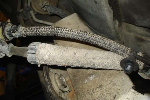PMA
Member
- Joined
- September 30, 2015
- Messages
- 29
- Reaction score
- 4
- Location
- Ontario, Canada
- City, State
- Parry Sound, Ontario
- Year, Model & Trim Level
- 2021 Explorer ST
I have a 2018 Explorer Sport with about 26,000 kilometres on it.
When in for service yesterday at the dealership I was advised there were only 2 mm of rear pads left and the rotors were pitted.
No city driving but we are in a northern climate. I do not drive the vehicle hard.
I was surprised they were worn so early. My 2015 Explorer was traded in with no brake issues at 50,000 km.
Any one experienced premature wearing of rear brakes and suggestions as to why?
Thanks
When in for service yesterday at the dealership I was advised there were only 2 mm of rear pads left and the rotors were pitted.
No city driving but we are in a northern climate. I do not drive the vehicle hard.
I was surprised they were worn so early. My 2015 Explorer was traded in with no brake issues at 50,000 km.
Any one experienced premature wearing of rear brakes and suggestions as to why?
Thanks













